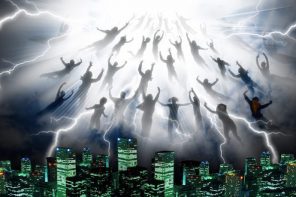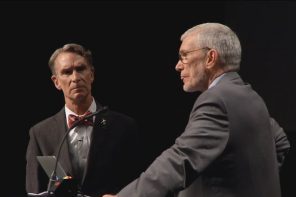Twilight wars in the Middle East, Japan’s nuclear catastrophe, Deepwater Horizon, worldwide crop failures, massive die-offs of long-established species: it’s all so very scary. Looming over all of it is the idea that we foolish humans have triggered some deep-level physical processes (methane gas release, ocean acidification, etc.) that now possess an ominous life of their own.
In these circumstances the word that slides naturally from the tongues of pundits is “apocalyptic.” It strikes many that we are now entering an apocalyptic scenario without precedent in recorded history. My interest here is comparing and contrasting the End Times as envisioned by certain of the faithful and the End Times as conceived by, say, James Hansen—the NASA climate change prophet. I’m interested not only in what the doomsday prophets say but also in how we receive what they say—in the part of ourselves that actually thrills to it.
But before parsing similarities and differences we might first consider the locus classicus for all things apocalyptic. That would be THE Apocalypse, a.k.a. The Revelation to St. John the Divine: the Technicolor showpiece that forms the very last book of the Christian Bible. For biblical scholars, “apocalyptic” refers to an entire genre of material generated by frightened people in trouble.
John’s Revelation grows out of the trials and tribulations of a persecuted early Christian community. The strands of apocalyptic in the Hebrew Scriptures (e.g., in the books of Daniel and Joel) concern the oppressions and dreams of deliverance experienced by groups of displaced Jews. What is called the Intertestamentary Period of Second Temple Judaism was marked by strong apocalyptic strains.
And for generations, scholars have argued about the extent of Jesus’ own apocalyptic consciousness. When Jesus speaks of an imminent judgment (Mt. 24-25, Mark 13, Luke 21), it’s clear that he’s referring to something his followers know about already—to a shared expectation that the End is near and that the End will be scary. Paul shares something of this same End Times consciousness; he clearly expects Christ to return in his own lifetime, although for him the expectation is less frightening than reassuring.
For Christians of a literalist persuasion, the End Times can be delayed but never denied. Thus there have been, at various intervals, moments of heightened expectation and frenzy. AD 1000 was a big one for the obvious reason that something major should be happening at the 1,000 year point—the millennium mark. In this country 1844 was a big year, thanks to the Millerite craze, while the last days of 1999 had pious folk worried about more than just computer failure. And then there are the millions and millions who could not and still cannot get enough of the Tim LaHaye and Jerry Jenkins Left Behind potboilers. At least LaHaye and Jenkins were smart enough to honor Jesus’ warning that “no one knows the day or the hour.” It made good business sense for them to honor it: the co-authors preferred to keep people guessing—and keep their book sales flowing.
I was once hooked on apocalyptic endings myself. In my early teens I became briefly fascinated by “The World Tomorrow” radio broadcasts of crackpot preacher Garner Ted Armstrong. And really, what 12-year-old kid living on an isolated Wisconsin farm would not be thrilled to learn that the Lost Ten Tribes of Israel later evolved into Angles and Saxons? Not to mention that the Stone of Scone used in British coronations over the centuries is the self-same stone that was used at the coronation of King David? I remember that Garner Ted’s manner regarding this malarkey was so calmly matter-of-fact. To me that authoritative tone of his was the clincher.
I mention this merely to illustrate how compelling and seductive apocalyptic thinking can be clearly a point of commonality between our religious and our non-religious apocalypticists. Both are talking about very grand and hair-raising events that are spinning out of control. Some other commonalities:
• Each version has its insiders, its lead prophets, who reveal or unveil End Time scenarios. This perfectly fits the apocalyptic genre, as the Greek root refers specifically to such uncovering.
• Each focuses on cumulative human folly and recalcitrance as the underlying source of impending doom. They define the folly somewhat differently, but in each case it is lust, cupidity, and willful disobedience that set the doomsday machine in motion.
• Each version features an offended deity. The biblical literalists believe that a righteous God must cleanse the earth of filth and corruption before Christ’s thousand-year reign on Earth can commence. Secular climate-change doomsayers may not use the term Gaia in their work or believe that Earth itself possesses consciousness, but they still tend to suggest that Mother Earth has been grievously wounded by the relentless abuse she has suffered—and that she will have her ways of striking back.
• Each apocalyptic frame preaches that radical repentance may yet allow erring humans to escape the worst.
Before proceeding, I want to acknowledge how pointless and offensive this whole line of inquiry must appear to some. Readers may well say, for example, that just because the doomsday warnings of certain environmentalists happen to exhibit formal similarities to what religious wingnuts are up to means absolutely nothing—and that it is preposterous and outrageous for me to imply that passionate environmentalists might in some way be unhinged in the manner of the End Times preachers.
Let me be clear: I am not saying that our best environmental prophets—not Jim Hansen, not Bill McKibben, not Wendell Berry, not Vandana Shiva—are “out there” in a way that should give us pause. These are all sober, scientifically-grounded people. But sober and well-grounded people who have seen the future and who are terrified by what they see find it rather difficult to put up with the temporizing and tergiversation that mark the mainstream response to such an overwhelming crisis. Their sense of acute urgency can easily be mistaken for fanaticism. And of course it is precisely that slight edge of hysteria that their well-organized opponents love to seize upon in order to dismiss them as mere cranks.
There are other marked differences between environmental prophets and faith-fueled apocalypticists. One is that the enviros aren’t talking about a single catastrophic moment or event but rather a series of events—albeit rapidly evolving—that will dramatically transform conditions on the planet. Another is that the enviros don’t believe for a minute that after the very bad days there will be some kind of clearing or deliverance in the way that millenarian Christians believe.
A third difference has to do with human agency. Most environmental prophets think it’s still possible—barely—that humans might just rise to the occasion and significantly change their destructive behavior. Most religious doomsayers do not seriously believe that any radical repentance will occur; and they rather hope that it won’t, because they so relish the thought of the wicked being consumed as the cups of divine wrath are poured out.
Doomsday Deferred: The Nuclear Overhang
It may be helpful to recall that popular anxiety about The End has actually been with us for quite some time—at least from the moment in July 1945 when Manhattan Project mastermind J. Robert Oppenheimer quoted Vedic scripture at Los Alamos: “I am become Death, destroyer of worlds.”
Many Americans actually felt pretty good about the nuclear bomb for a little bit, though that changed once those damned Russkies got a bomb of their own. Partly to allay growing fears of annihilation, President Eisenhower in 1953 began heavily promoting the “Atoms for Peace” concept through which the lethal nuclear fission process might be seen as but another mainstay of American prosperity, powering our homes and factories with new supplies of electric power that would be “too cheap to meter.” In 1957 Walt Disney even released a movie titled Our Friend, the Atom.
Looking back now, it’s quite easy to see why the happy talk from Ike and Walt failed to quell our nuclear nightmares. In somewhat the same way that climate change denialism functions today, the Atoms for Peace campaign merely divided public opinion, allowing some to sleep easy and the most knowledgeable people even more distraught and fearful. Events like the recent reactor meltdown in Northeastern Japan can bring even the sleepers back to the edge of anxiety, and then there’s the persistent fear that a nut job or a terrorist will decide to usher in apocalypse using nuclear materials.
The relevance of living in the nuclear shadow to living in the climate change shadow is simply this: apocalyptic fear cuts both ways. It can spur some palliative action, but it can also cause people to cling to false hopes and delusions and shut down their capacity for creative responses. Such people think: We’ve gone almost seven decades without destroying the earth in a thermonuclear holocaust—surely we’re not going to let a little thing like melting polar ice caps trouble us, are we?
Spreading fear can also prompt another unhelpful reaction: what we might call the “fear junky” response in which we actually become attached to the fear and create a whole culture around it, as with the Godzilla cult that grew up in Japan in the wake of Hiroshima and Nagasaki. We see something like that today in the activities of radical environmentalists who don’t actually organize for change but prefer to wallow instead in the pornography of planetary decline and death.
A Proposal: Try Working Under the Rainbow Sign
For everyone purveying apocalyptic scenarios—for the biblicists as well as for the distraught secularists—there might be some wisdom and some consolation in recalling the Rainbow Sign that God gave to Noah following the Great Flood (Genesis 8). In this never-revoked covenantal promise God says: “I will never again curse the ground because of humankind… As long as the earth endures, seedtime and harvest, cold and heat, summer and winter, day and night, shall not cease.”
Biblicists might wish to take to heart the fact that in making this pledge, God acknowledges that “the inclination of the human heart is evil from youth,” but God also says very clearly that human evil will never again warrant a divine vendetta against the whole human race. So the biblicists need to consult their Bibles in order to see that their idea about the weight of human sin triggering apocalyptic destruction has no scriptural support.
For secular environmental prophets, the Rainbow Sign takeaway will be quite different. These folks never imagined that God would or could undo God’s own glorious creation. For them divine action (or divine inaction) cannot be an issue. But might they not also find some calming and some hope within the poetry of Genesis 8?
There’s a lot of hope, I think, in that image of the earth spinning peacefully on its axis, with seedtime and harvest coming perpetually and with the God of the Bible promising to just let it be. Because if nature is ordered in this way, why on earth would we humans wish to disturb it? Why would we want to be the ones to bring the whole thing down?
And then there’s all that planting and building that begins to take place almost immediately under the Rainbow Sign. Here, too, is a clue for our environmental doomsayers: Don’t disdain all economic activity so much, but redirect it toward higher ends. If your only alternative to the Peak Oil economy is a nuts-and-berries economy, you have already lost. Try to show how the sustainability path is a joyful path, not a grim monastic path.
It may be true, as many have said, that the next revolution—the green revolution—will be the first revolution in history that cannot promise material advancement in the same way that people have traditionally construed such advancement. But that does not mean we will be living immaterial lives, or that living much more modestly upon the earth will not prove to be quite sublimely satisfying. Teach that, please! And bring your poets, not your polymaths, to the front lines of the green revolution.
Getting energy from fossil fuels has proved itself to be unsustainable in a big way. Almost everyone gets that now. Do not imagine, however, that human energy can be shut down or thwarted. Learn to view it as William Blake viewed it—as an eternal and irrepressible delight.
Yes, dear ones: The End Is Near! But it is the end of a lifestyle that was weighted down with overconsumption in the first place. No need to be so grim and (dare I say it?) so apocalyptic in our approach to changing it up.




